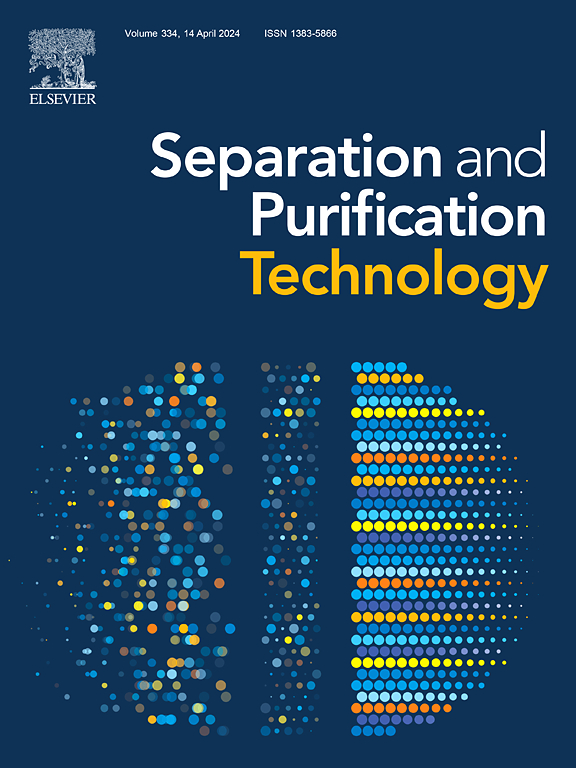Ligand-tailored Co-O bond strength in MOF-derived Co3O4 for boosting NO oxidation
IF 9
1区 工程技术
Q1 ENGINEERING, CHEMICAL
引用次数: 0
Abstract
Recent intensive research has established that modulating oxygen species activity in transition metal oxide (TMO) catalysts is pivotal for catalytic NO oxidation, which is regarded as a key step that governs NOx abatement technologies. Despite this recognition, the fundamental relationship between metal–oxygen bond strength and the intrinsic catalytic properties of TMOs remains poorly understood. To address this gap, we fabricated dodecahedral-, rod-, and sphere-like Co3O4 catalysts (Co3O4-D, Co3O4-R, Co3O4-S) with tunable Co-O bond covalency using a MOF-templating strategy. Systematic evaluation revealed a distinct activity trend, wherein Co3O4-D displays the best activity, for which a maximal NO conversion (82.0 %) could be attained at 250 °C under a WHSV of 150, 000 mL·g−1·h−1, followed by Co3O4-R (75.0 % at 275 °C) and Co3O4-S (66.0 % at 300 °C). Mechanistic studies demonstrate that weakened Co-O bond strength enhances catalytic function through dual pathways: (1) lowering the energy barrier for oxygen vacancy formation, which accelerates surface lattice oxygen activation and improves the intrinsic redox capability; (2) preferentially exposing undercoordinated Co-O sites that serve as main active sites for NO adsorption and subsequent conversion to NO2. This work provides a theoretical foundation for designing high-efficiency NO oxidation catalysts by leveraging MOF-templated structural and electronic regulation.


mof衍生Co3O4的配体定制Co-O键强度促进NO氧化
近年来的大量研究表明,调节过渡金属氧化物(TMO)催化剂中氧的活性是催化NO氧化的关键,这被认为是控制NOx减排技术的关键步骤。尽管认识到这一点,金属-氧键强度与TMOs的内在催化性能之间的基本关系仍然知之甚少。为了解决这一问题,我们利用mof模板策略制备了十二面体、棒状和球状Co3O4催化剂(Co3O4- d、Co3O4- r、Co3O4- s),这些催化剂的Co-O键共价可调。系统评价显示出明显的活性趋势,其中Co3O4-D表现出最好的活性,在150000 mL·g−1·h−1的WHSV下,在250 °C时NO转化率最高(82.0 %),其次是Co3O4-R(275 °C时75.0% %)和Co3O4-S(300 °C时66.0 %)。机理研究表明,Co-O键强度减弱可通过两种途径增强催化功能:(1)降低氧空位形成的能垒,加速表面晶格氧活化,提高内在氧化还原能力;(2)优先暴露Co-O位,这些Co-O位是NO吸附和随后转化为NO2的主要活性位点。本研究为利用mof模板化结构和电子调控设计高效NO氧化催化剂提供了理论基础。
本文章由计算机程序翻译,如有差异,请以英文原文为准。
求助全文
约1分钟内获得全文
求助全文
来源期刊

Separation and Purification Technology
工程技术-工程:化工
CiteScore
14.00
自引率
12.80%
发文量
2347
审稿时长
43 days
期刊介绍:
Separation and Purification Technology is a premier journal committed to sharing innovative methods for separation and purification in chemical and environmental engineering, encompassing both homogeneous solutions and heterogeneous mixtures. Our scope includes the separation and/or purification of liquids, vapors, and gases, as well as carbon capture and separation techniques. However, it's important to note that methods solely intended for analytical purposes are not within the scope of the journal. Additionally, disciplines such as soil science, polymer science, and metallurgy fall outside the purview of Separation and Purification Technology. Join us in advancing the field of separation and purification methods for sustainable solutions in chemical and environmental engineering.
 求助内容:
求助内容: 应助结果提醒方式:
应助结果提醒方式:


